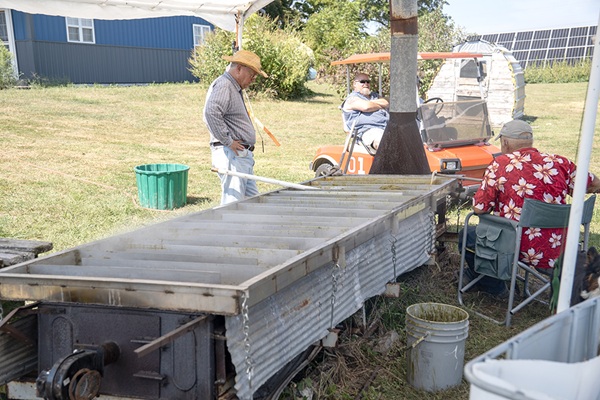
The Hancock-Henderson Quill, Inc.
In the fields east of Blandinsville, Illinois, James Taylor keeps a family tradition alive, crafting sorghum syrup with the same dedication as his father and grandfather before him.
Originally from Kentucky, where he grew up around sawmills and tobacco fields, Jim has been making sorghum syrup for over 20 years.
The ritual takes place each late summer or early fall before the first frost. “It’s the way my granddad did it,” Jim says, a nod to the time-honored methods passed down through generations.
The process begins with 12 rows of sorghum cane, each stretching about 100 feet, grown from seeds with a storied history.
Originally sourced from Ohio in 1932, the seeds made their way to Kentucky and now thrive in the fertile soil of west central Illinois.
Jim plants each year’s crop using seeds saved from the previous harvest, ensuring continuity.
Tending the field is no small feat—Jim hoes it by hand three times and cultivates it twice to keep weeds at bay, a labor of love that reflects his commitment to quality.
Harvest day is a community affair, starting at 7:30 a.m. and wrapping up around 3 p.m.
Armed with a corn knife, Jim and a dozen friends cut the mature sorghum stalks, which tower 8 to 12 feet tall, by hand.
The leaves and seed heads are stripped away, leaving the stalks ready for pressing. The press, patented in 1882 and originally horse-powered, is a piece of history.
Jim has modified it to run on a belt, blending tradition with practicality.
Once harvested, the stalks are fed through a roller mill to extract a green, watery juice. This juice is strained to remove debris, then poured into a custom production pan Jim built 20 years ago. The pan sits over a wood-fired burner from the early 1900s, which transforms the juice into syrup.
As it boils, Jim and his crew skim off the greenish froth and impurities, a critical step to ensure clarity.
The juice simmers for hours, reducing significantly; it takes 10-12 gallons of juice to yield just one gallon of syrup. The syrup is strained again through cheesecloth for a smoother finish.
The day is as much about community as it is about syrup. Jim’s wife, Bonnie, and other helpers prepared a hearty spread to fuel the crew: biscuits and gravy for breakfast, followed by chili, lasagna, and ham and beans for lunch.
Laughter and stories fill the air as friends work together, united by the shared goal of preserving this craft.
Over the years, Jim’s best yield was 33 gallons of syrup, a testament to the group’s hard work and the quality of the cane.
Visitors to the farm are often treated to a taste of tradition—like a warm sorghum cookie, reminiscent of old-fashioned treats like the popcorn balls my grandma used to make.
“It’s hard to find fresh, pure sorghum now,” Jim notes, making his syrup all the more special.
As the day winds down, the golden syrup is bottled, ready to be shared with family, friends, and neighbors.
For Jim, each batch is a connection to his Kentucky roots, his family’s legacy, and the land he now calls home.
In an era of mass production, his dedication to crafting sorghum syrup the old-fashioned way is a sweet reminder of simpler times.

Pat Cordell (left) of Colchester and James Taylor (right) of Blandinsville monitor the production pan on a warm September afternoon.